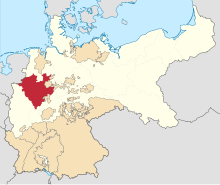
Back Вестфалія (правінцыя) Byelorussian Proviñs Westfalen Breton Província de Westfàlia Catalan Provinz Westfalen German Provinco Vestfalio Esperanto Provincia de Westfalia Spanish Vestfaali provints Estonian استان وستفالیا Persian Westfalenin provinssi Finnish Province de Westphalie French
This article needs additional citations for verification. (October 2017) |
| Province of Westphalia Provinz Westfalen | |
|---|---|
| Province of Prussia | |
| 1815–1946 | |
 Westphalia (red), within the Kingdom of Prussia, within the German Empire | |
| Anthem | |
| Westfalenlied | |
| Capital | Münster |
| Area | |
• 1817 | 20,215 km2 (7,805 sq mi) |
| Population | |
• 1925 | 4,784,000 |
| History | |
• Established | 1815 |
• Disestablished | 1946 |
| Political subdivisions | Arnsberg Minden Münster |
The Province of Westphalia (German: Provinz Westfalen) was a province of the Kingdom of Prussia and the Free State of Prussia from 1815 to 1946.[1] In turn, Prussia was the largest component state of the German Empire from 1871 to 1918, of the Weimar Republic and from 1918 to 1933, and of Nazi Germany from 1933 until 1945.
The province was formed and awarded to Prussia at the Congress of Vienna in 1815, in the aftermath of the Napoleonic Wars. It combined some territories that had previously belonged to Prussia with a range of other territories that had previously been independent principalities. The population included a large population of Catholics, a significant development for Prussia, which had hitherto been almost entirely Protestant. The politics of the province in the early nineteenth century saw local expectations of Prussian reforms, increased self-government, and a constitution largely stymied. The Revolutions of 1848 led to an effervescence of political activity in the province, but the failure of the revolution was accepted with little resistance.
Before the nineteenth century, the region's economy had been largely agricultural and many rural poor travelled abroad to find work. However, from the late eighteenth century, the coal mining and metalworking industries of the Ruhr in the south of the province expanded rapidly, becoming the centre of the Industrial Revolution in Germany. This resulted in rapid population growth and the establishment of several new cities which formed the basis of the modern Ruhr urban area. It also led to the development of a strong labour movement, which led several large strikes in the late nineteenth and early twentieth century.
After World War II, the province was combined with the northern portion of Rhine Province and the Free State of Lippe to form the modern German state of North Rhine-Westphalia.
- ^ Mitchell, Maria (2012). The Origins of Christian Democracy: Politics and Confession in Modern Germany. University of Michigan Press. p. 141. ISBN 978-0472118410.
© MMXXIII Rich X Search. We shall prevail. All rights reserved. Rich X Search

